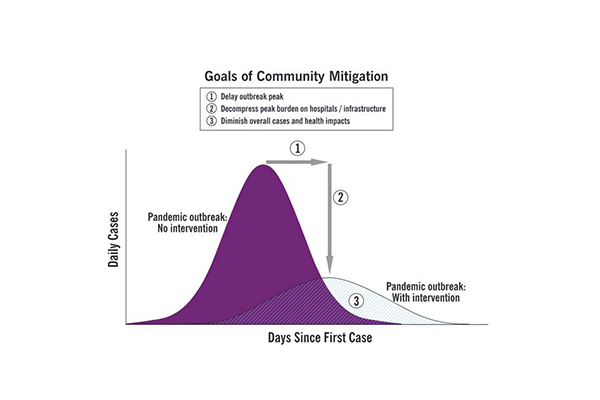Press Release
Johns Hopkins APL Experts Explain Why Social Distancing Is Critical to Flattening the Coronavirus Curve
In an effort to slow the spread of COVID-19, two phrases have been thrust into the worldwide lexicon: social distancing and flattening the curve. As the U.S. contends with the exponential growth of the virus, and testing and treatments race to catch up, public health experts are shouting these proactive measures from the rooftops.
Underscoring their plea, a graph the Centers for Disease Control and Prevention created 13 years ago to describe these measures was given new life on social media and in newsroom animations. The two phrases have become a rallying call, and an instructive tool on how humanity can work together to mitigate this pandemic’s impacts.

Credit: CDC
Social distancing, avoiding contact closer than six feet with anyone who doesn’t live in your home, aims to reduce opportunities to transmit the virus between parties and, as a result, flatten the curve (slowing its spread to prevent illness surges that could overwhelm health care systems). But why are social distancing and flattening the curve so important?
“Social distancing decreases the number of interactions potentially infected individuals have with the susceptible population: everyone else,” explained Claire Marie Filone, a virologist with expertise in biodefense and emerging infectious diseases at the Johns Hopkins Applied Physics Laboratory (APL) in Laurel, Maryland. “This measure is particularly important when asymptomatic individuals are infectious. They feel fine, but they’re transmitting the virus. If an infectious person interacts with fewer individuals, there’s a smaller chance of passing the virus and furthering the outbreak.”
“Trying to flatten the curve is important because a huge spike in cases per day, as indicated by the graph’s first peak, will overwhelm our under-prepared health care system,” she continued. “We flatten it by practicing social distancing.”
It sounds simple. And it’s easy to hope that taking the measures many states have — closing schools, restaurants and bars, or canceling sporting events and stadium gatherings — will stop the virus’ transmission. They won’t.
“Flattening the curve is not a cure,” Filone said. “The virus will still spread through the community, just at a slower pace.
“We are protecting the institutions that keep us safe — our hospitals and health care infrastructure, as well as front-line workers and others who interact with the community daily. Flattening the curve extends the amount of time we see steady, though hopefully slower, increases in infections per day.”
Jared Evans, a molecular virologist at APL who has expertise in emerging infectious diseases, added: “The number of trained health care personnel is lower than what would be required to handle the number of ill at the peak. Social distancing and, as a result, flattening the curve, allows efforts to move from a defensive posture to a more proactive one where we can fully understand the virus, its infectivity, transmissibility, and outcomes of infection to more effectively treat and stop it.”
It’s in part why actions viewed as drastic are integral, but not the sole focus.
"Community interventions like event closures play an important role," Caitlin Rivers, an epidemiologist from the Johns Hopkins Center for Health Security, told the Hub, the news center for Johns Hopkins University. “But individual behavior changes are even more important. Individual actions are humble but powerful."
One thing to remember, Filone noted, is that overwhelming the health care system doesn’t just affect patients infected with COVID-19. By reducing the exponential growth of the virus, providers will be able to deliver continuing care for pediatric and maternal patients, cancer patients, and other emergent situations like heart attacks, car accidents and much more.
“Slowing the spread of the virus allows us to prepare,” she said. “It allows us to create and produce more diagnostic tests, try new treatments and, eventually, evaluate and produce vaccines.”
Unfortunately, one thing public health experts cannot be sure of at this point is how long it will take — and how much social distancing will be required — to effectively flatten the curve.
“The more people who participate, the sooner plans can take hold and, hopefully, the sooner the curve can flatten,” Evans said. “It’s certainly disruptive, but it may give researchers the time we need to significantly decrease the overall impact of the virus in the U.S.”
“As the numbers increase exponentially with expanded testing, we must remember that this indicates prior infections and patterns of spread — which have gone undiagnosed for weeks — as well as current spread in the community,” Filone added. “But we need the data to understand where each part of the country is on that curve currently, pre- or post-intervention with social distancing.”
In the meantime, Filone and Evans stressed that avoiding panic is important, as is viewing the current measures as a way to assist your community as opposed to a punishment. They also agreed it’s imperative to take proper precautions, like washing your hands and cleaning surfaces, and to think rationally about food- and supply-buying behaviors.
“Check on your loved ones and neighbors and see how they’re doing — while adhering to social distancing, of course,” Evans said. “Everyone is in this together, and observing recommended public health measures improves the outlook for us all.”
Many researchers at APL are working to support the U.S. response to the COVID-19 outbreak.
In the absence of sufficient, widespread testing, a public health electronic surveillance tool developed by APL is helping to fill gaps by tracking the virus’ spread symptomatically; data analytics efforts in aiding the Center of Excellence for Influenza Research and Surveillance (CEIRS) for sequencing of COVID-19 samples at Johns Hopkins Hospital are underway; and staff members are assisting in data cleaning and processing, as well as assurance, with JHU’s COVID-19 dashboard.